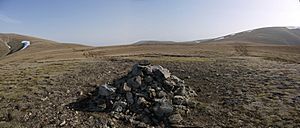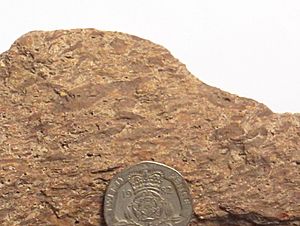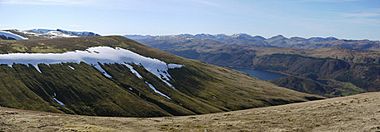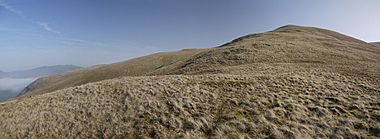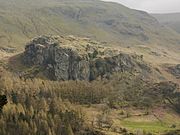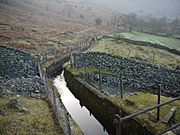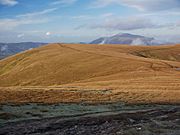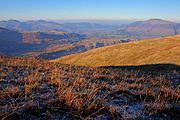Watson's Dodd facts for kids
Quick facts for kids Watson’s Dodd |
|
|---|---|
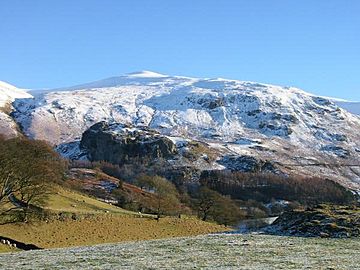
Watson’s Dodd from the west, with Castle Rock in front of the steep craggy end of the fell
|
|
| Highest point | |
| Elevation | 789 m (2,589 ft) |
| Prominence | 11 m (36 ft) |
| Parent peak | Great Dodd |
| Listing | Wainwright |
| Geography | |
| Location | Cumbria, England |
| Parent range | Lake District, Eastern Fells |
| OS grid | NY336196 |
| Topo map | OS Explorer OL5 |
Watson's Dodd is a cool fell (which means a hill or mountain) in the English Lake District. It's a smaller bump on the main ridge of the Helvellyn range in the Eastern Fells. But, it looks like a big shoulder on the west side of that mountain range.
Right at its base is an amazing rocky cliff called Castle Rock. Rock climbers love this spot and have found about 60 different ways to climb up it!
Contents
What is Watson's Dodd Like?
From the west, Watson's Dodd looks like a clear shoulder on the Helvellyn ridge. It's just north of Sticks Pass. The very top of Watson's Dodd sits on the main Helvellyn ridge. This is where the south-west ridge of Great Dodd and the north-west ridge of Stybarrow Dodd join up.
From this spot, a "shoulder" (a sloping part of the mountain) goes down into the valley of How Beck. This part is called the High Fells of St John's Common. It has steep sides thanks to the deep valleys of Mill Gill to the north and Stanah Gill to the south. The slope is gentle at first, then gets steeper with some rocky cliffs. Just before the valley, part of this shoulder rises up again to form the tall, rocky Castle Rock.
On the eastern side, Watson's Dodd doesn't have much of a slope. A deep valley called Browndale Beck separates Great Dodd from Stybarrow Dodd. So, Watson's Dodd mainly has a triangular top area on this side.
The highest point of Watson's Dodd is 789 meters (about 2,589 feet) high. It only rises 11 meters (about 36 feet) above the dip that separates it from Stybarrow Dodd.
Watson's Dodd is on the main watershed. This means it separates the rivers that flow west into the Derwent system from those that flow east into Ullswater and the Eden river system. Water from the west side is now collected by a special channel and sent to the Thirlmere reservoir.
The Famous Castle Rock
Castle Rock stands at the top of the Vale of St John's. It's a nearly straight-up rock that sticks out from the hillside. It has rocky faces on three sides. The rock looks a bit like a castle, and it's even prettier with trees growing around its lower parts.
People have admired this rock for a long time. In 1778, Thomas West called the valley "nobly ended by the castle-like rock of St. John." Jonathan Otley, in 1823, knew it as "the massive rock of Green Crag, sometimes called the Castle Rock of St. John's."
Sir Walter Scott, a Scottish writer, wrote a poem called The Bridal of Triermain in 1812. In his poem, Castle Rock is the setting for an Enchanted Castle. The hero, Sir Roland de Vaux, has to rescue a maiden named Gyneth from it.
Because of Walter Scott's poem, climbers sometimes call it Castle Rock of Triermain. This helps them tell it apart from another Castle Rock in a different part of England.
Climbers have found and named over 60 different ways to climb this rock! The North Crag is 75 meters (246 feet) high and very steep. It was first climbed in 1939. However, since 2011, the North Crag has been thought to be dangerous. A large crack has opened at the top, which could cause a big rockfall. The South Crag is 35 meters (115 feet) high. It's not as steep, gets more sun, and dries faster, so it has easier climbing routes.
The very top of Castle Rock is 339 meters (1,112 feet) high. It rises 29 meters (95 feet) from the hillside behind it.
Reaching the Top of Watson's Dodd
The top of Watson's Dodd is a grassy, triangular area. It slopes gently to the east and has paths on all three sides. The highest point is at the western tip of the triangle. A small pile of stones, called a cairn, marks this spot.
The view from the top is amazing! Since it's on the west side of the main ridge, you can see all around. You can see Blencathra and Skiddaw in the north, and the Coniston mountains in the south. The view stretches over Thirlmere to the central fells, and you can also see the western and northwestern fells. On a clear day, you might even see the hills of south-west Scotland!
How to Climb Watson's Dodd
You can start your climb from the B5322 road. There are places to park at Legburthwaite or at Stanah village hall. There aren't any special marked paths directly up the hillside. But if you stick to the top of the ridge (after getting past the first rocky parts, or after visiting Castle Rock if you want), you'll easily find your way to the cairn at the top.
You can also reach the summit by following the popular paths along the main Helvellyn ridge. However, many people walking the ridge seem to walk past the very top of Watson's Dodd without stopping there.
The Rocks of Watson's Dodd
The rocks that make up Watson's Dodd are all part of the Borrowdale Volcanic Group. These rocks formed about 450 million years ago, during a time when there was a lot of volcanic activity. This was in the Ordovician Period.
Most of the rocks here are from the Birker Fell Andesite Formation. These are some of the oldest volcanic rocks in the Borrowdale Volcanic Group. They are made of thick layers of andesite rock. These layers formed from many eruptions of runny lava from volcanoes that were not very steep.
Sometimes, between these lava flows, you can find layers of sandstone made from volcanic material. The geological map shows small amounts of this on the hillside. There are also some rocks called lapilli-tuff, which formed from more explosive eruptions.
After the Birker Fell Formation eruptions, the lava changed. It became more like dacitic rock, which meant the eruptions were much more explosive. In the area north of Sticks Pass, the Birker Fell andesite rocks are covered by the Lincomb Tarns Tuff Formation. This formation is one of the most common volcanic rocks in the Lake District. It seems the whole area was covered by at least 150 meters (about 490 feet) of a rock called ignimbrite. This rock forms from very hot gas and rock flowing out of a volcano. This formation must have come from a series of huge eruptions, probably when a volcanic caldera (a large crater) formed where Helvellyn is today.
On Watson's Dodd, this formation has two parts. The Tarn Crags Member makes up Castle Rock. It's also a thin layer higher up the hillside. It's a coarse-grained dacitic lapilli-tuff. Above this thin layer are rocks from the Thirlmere Tuff Member, which covers the top of the fell. First, there's an area of volcanic breccia, which forms small rocky outcrops. Above that is a thick layer of welded rhyo-dacitic lapilli-tuff. In this rock, the pieces of semi-melted lava (the lapilli) were flattened by the weight of the layers above them. This rock turns white or pink when it weathers. But it's covered by the smooth, grassy ground that you see on Great Dodd, Watson's Dodd, and Stybarrow Dodd, as they are all covered by the same layer.
What's in a Name?
The word "Dod" or "dodd" is an old local word. We don't know exactly where it came from. But it's often used for bare, rounded hilltops in the Lake District and the Scottish Borders. These can be hills that stand alone or smaller parts of bigger mountains.
We don't know who the "Watson" was that this fell is named after. There might be a link to Watson's Park, which is in the same area. If so, the name was first written down in 1734. This means Watson must have lived no later than the early 1700s.
Image gallery



